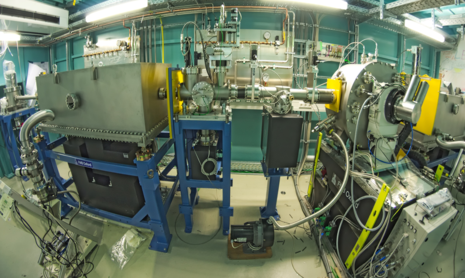
Just prior to the winter shutdown a significant milestone was reached in the commissioning of the new beamline for catalysis- and radionuclide research CatAct at the Karlsruhe synchrotron radiation source ANKA: the step-by-step alignment of the optical components, starting from the radiation source itself - a superconducting wiggler in the storage-ring – all the way to the high-precision mirrors which focus and guide the highly intensive X-rays to the two new experimental stations. The experimental stations themselves are located in two new laboratories: for “Catalysis research”, jointly operated by the KIT Institute for Technical Chemistry & Polymer Chemistry (ITCP) and the Institute for Catalysis Research and Technology (IKFT), and for “Actinde science”, operated by the Institute for Nuclear Waste Disposal. The two experimental facilities are operated alternately. In the first week of December 2015 the first X-ray absorption spectra were acquired from materials related to both research areas.
One of the main research areas of ITCP/IKFT is the development of application-oriented catalysts, for example, as energy-storage materials for wind- and solar- generated power, or for purification of exhaust-gases, where due to increasingly stringent limits on exhaust-gas emissions for both diesel- and petrol-powered vehicles exhaust-gas catalysts are playing an increasingly important role (at present this consumes more than 50% of the available precious metal production, in particular Pt, Rh, and Pd.) The application of synchrotron radiation techniques makes it possible to investigate catalytic processes under real reaction conditions, which in turn allows the direct application of the results gained to current industrial and academic problems, for example in the design, fabrication and modelling of catalysts. X-ray spectroscopic measurements such as those carried out at the CatAct facility provide a unique insight into the electronic and atomic structure of the precious-metal constituents of these catalysts, making a key contribution to the optimization of their performance and consequent reduction in the usage of these expensive materials. The pilot experiments carried out on such platinum catalysts in December at CatAct are a foretaste of the research possibilities now available at the beamline: from early 2016 the new facility at ANKA will offer a worldwide unique experimental station and infrastructure targeted towards application-oriented investigation of catalyst systems, both for university and program-oriented research (SCI, STN, EE, and MML).
Alongside current advancements in the production and processing of environmentally sustainable catalyst and energy storage materials, the safe, long-term storage of waste materials from nuclear power-generation represents a massive scientific, technical and societal problem. A scientifically sound and socially acceptable waste-disposal concept demands detailed understanding of the mid-term and long-term behaviour of highly active, heat-producing nuclear waste materials (in particular reactor fuel-rods and vitrified high-level processed wastes) in intermediate and in future long-term geological repositories. Ensuring that these materials remain permanently isolated from the biosphere requires an understanding of their complex materials science, for example the relationship between chemical state and leaching-properties of uranium and other radionuclides in waste-glasses. Also in this field X-ray absorption spectroscopy delivers directly applicable results, as was illustrated by pilot-experiments on simulated, uranium-doped borosilicate nuclear waste glasses. With a license to investigate radio-isotopes up to 106 times the exemption limits, the new ACT-Station at ANKA, together with the existing INE-Beamline and the direct proximity of the radionuclide laboratories of both INE and the European Commission’s Institute for Transuranium Elements (JRC-ITU), is recognized as presenting unique possibilities for the investigation of nuclear safety-relevant waste disposal at the European level. These facilities are available to both the national and international user community within the HGF NUSAFE program and via strategic research cooperations.
